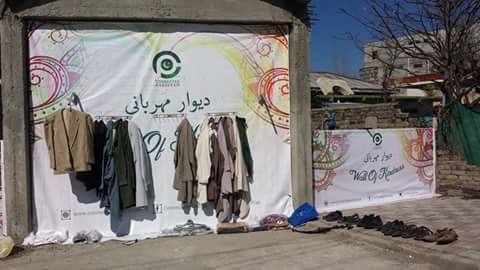 | ||
The wall of kindness (Persian: دیوار مهربانی dīvār-e mehrabānī; Urdu: دیوار مہربانی) is a charity work phenomenon and a kind of welfare, usually done by attaching cloth hangers from outside of houses; those encourage people to donate miscellaneous useful things such as winter clothing. It was introduced by an anonymous Iranian, and the practice quickly spread throughout the country. The motto of the movement are two sentences which appear on the walls: "leave if you do not need" (نیاز نداری بگذار) and "take [it] if you need" (نیاز داری بردار).
Contents
Description
Initially started for the homeless people of the Mashhad, Iran, the act serves a purpose to support the people in need. In response to social media, large numbers of people are taking part as a campaign and it has helped many homeless or otherwise destitute people during the cold winter weather.
A similar initiative, but with open fridges, spread from Tehran to other cities. Bookshelves are also being added to the Walls of Kindness in order to donate books specially for poor children
A wall of kindness was seen in Pakistan's Karachi on 15 January 2016 and another one in China's Liuzhou, located in Guangxi Zhuang Autonomous Region on 29 January 2016. Also students of Marymount International School of Rome, in April 2016, have reproduced the idea by designating a wall with similar function and name. A wall of kindness was set up in Peshawar by Serve Mankind & Wadaan and afterwards it started Spreading all over Pakistan such as, Rawalpindi, Lahore, Sialkot, Quetta, Khuzdar and Karachi have witnessed similar walls where people are leaving clothes and other essential items for the poor.
Similar walls known as "Neki ki Deewar" have sprung up in multiple cities across India such as Allahabad, Bhilwara, Jhalawar, Chandigrah, Bhopal, Dehradun and Korba sometimes even having more supply than demand of clothes. The walls are also serving unexpected purpose of keeping walls clean and free from spitting.
Background
The economy of Iran was hit when sanctions were imposed by the Western World. As the situation became worse, with an increasing number of unemployed, many could not afford clothes. Inflation caused particular difficulties for those in need. In the winter of 2015, young Iranians in Sajjad Boulevard in Mashhad came up with the idea. The main theme was to meet the demand for resources from charities. For the first time, a wall symbolizes unity rather than separation and the community has been asked to donate voluntarily. As soon as the attempt came to the attention of various social and mass media platforms, it was supported and praised by citizens as well as netizens.
Young Iranians took the chance to strengthen the bonds of community. The campaign went smoothly despite the risk of misuse and loss of resources. People were responsive and well aware of the fact that most vulnerable should get priority.
Winter clothing disbursed among mass number of people as a welfare had been seen before, but still, the idea was innovative and showed much intelligence.
Impact
The sharing works of charity had a great impacts of religious point of view regarding Islamic country like Iran. Like in other religions, charitable work is considered a virtue in Islam, which has driven people to do more for humanity. Like in Iran, people in Pakistan are showing their humanity via this initiative.
